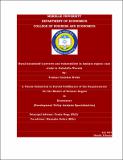| dc.description.abstract | Poverty has becomes a pervasive phenomenon in the world particularly in sub-Sahara Africa in where Ethiopia is located. Notably, households in rural areas are highly vulnerable to poverty because of the frequently occurring environmental and health related shocks. In spite of effort on poverty reduction and achievement of sustainable development during the past, poverty remains pervasive and households highly vulnerable to the emergence relief food aid in the Gubalafto woreda. The paper aims to analyze the extent of poverty and vulnerability to poverty as well as the correlates of poverty, and vulnerability to poverty. Primary data was used from the stratified random sample of 250 households drawn from three agroecological zones of Gubalafto woreda, Amhara region. In line with the cost of basic need (CBN) approach, total poverty line of the study area is Birr 294.6 per month per adult equivalent. Foster, Greer and Thorbecke (FGT) group of poverty measures, 3FGLS and the Gini coefficient were utilized to estimate the extents of poverty incidence, mean vulnerability to poverty and consumption inequality index, which is reckoned as 30.08%, 37.42% and 26.83 % respectively. This study applied multiple regression analysis to identify the correlates of household welfare and the level of vulnerability to poverty, and also the censored regression model (Tobit) used to analyze the determinants poverty gap and poverty severity. Accordingly, family size, employment on wage, distance to the main market and agroecological dummy affect welfare negatively and significantly but they affect the poverty gap and poverty severity positively. On the other hand, oxen, land size, asset value, employment on own business, access to credit and access to extension service affects the welfare status positively and significantly, but they affect the poverty gap and severity negatively. Moreover, head age, mean age of household, oxen and asset holding, own business activity, access to credit and extension services and village level infrastructural facility affect household vulnerability negatively and significantly, while head male, number of children, dependency ration, distance to the main market and kolla agroecological dummy affect positively. In general, the household characteristics, asset holding, off-farm income participation, access to public services such as access to credit and agricultural extension services, village level infrastructural facilities, access to market and agroecological variation were considered as the main determinants of household's welfare, intensity of poverty and vulnerability to poverty in the study area. | en_GB |


